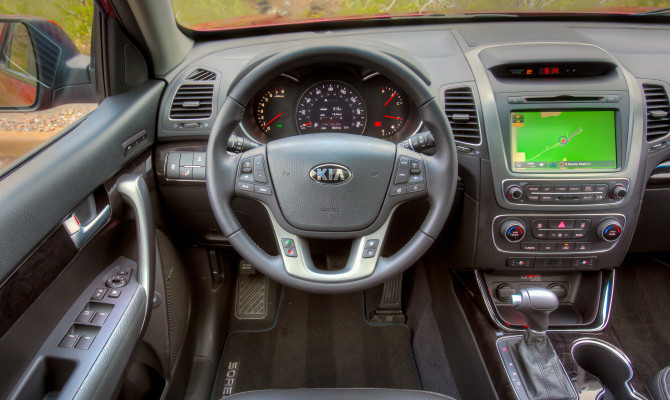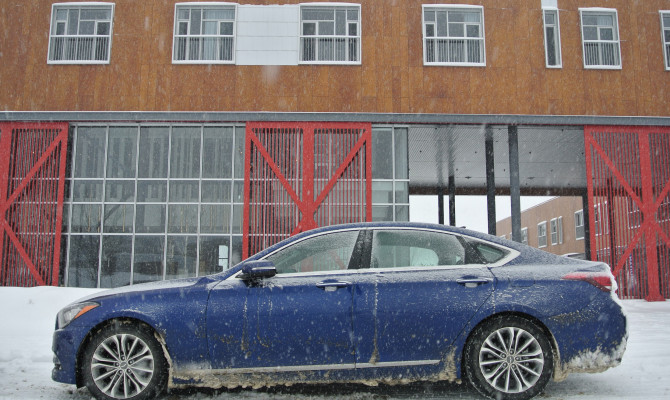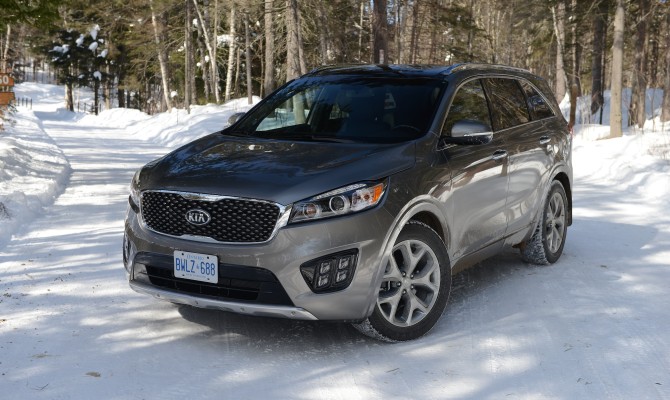“Part of winter driving, especially in these blizzard conditions, is largely about the tires.”
Baie-Saint-Paul, Quebec.
Certain car brands are synonymous with defined traits.
Say the word “performance” and you’ll likely get a group of people talking about German engineering. Say the word “safety” and chances are a certain Swedish automaker will be at the top of the list.
What brands come to mind when you think of an all-wheel drive system?
I’m guessing Japanese, also German but how about Korean?
Okay, Hyundai is not the first automaker to come to mind when it comes to their AWD technology. It probably isn’t the second or even third. That said, they’re on a mission to change peoples’ minds.
Hyundai offers two distinct types of AWD systems. One is used with platforms designed for front-wheel drive systems to enhance traction while maintaining fuel efficiency; the second is for rear-wheel drive based platforms and is programmed to increase performance while maintaining control and drivability in slippery road conditions.
I had the chance to test both them out in extreme winter conditions and Baie-Saint-Paul, Quebec, certainly delivered on that promise! – I’m not entirely sure how much snow fell in the time my driving partner and I left the hotel for our morning exercises at Le Massif de Charlevoix ski area, but it seemed like 30 centimetres or more.
No, we didn’t shuttle people up and down the mountain to prove its capabilities. A closed course was set up with more than enough ice underneath to make things very interesting.
We’d put both the Genesis sedan and Santa Fe XL Crossover to the test.
Let the slipping and sliding commence. Part of winter driving, especially in these blizzard conditions, is largely about the tires. No matter how good an AWD system controls the torque split between the front and rear axels, if you don’t have grip, well, then it can get really interesting. Like, Santa Fe XL meet the snow bank. Snow bank meet the Santa Fe XL. Luckily, this wasn’t the case.
Each vehicle had its own play area. The Genesis sedans played more on a skating rink-like surface while the Santa Fes romped in the snow. However, the icier surface was soon heavily covered in snow and visibility became quite grim. The activities were cut short but our drive route wasn’t.
The HTRAC (which stands for Hyundai TRACtion) all-wheel drive system of the Genesis did work at getting us out of some sliding situations. As a bonus for 2015, the Genesis sedans come standard with all-wheel drive. So, if you happen to find yourself stuck in a snowstorm, you need not panic.
HTRAC also has some cool features associated with it. The AWD control logic is different according to driving mode selection for enhanced drivability and efficiency.
For example, with the vehicle set in “Normal” mode, HTRAC defaults to a 40:60 rear-wheel biased torque distribution. The system can shift as much as 90 percent of engine output to the front axle in slippery conditions or 100 percent to the rear at higher speeds for reduced driveline drag and improved fuel economy.
At speed in “Sport” mode, HTRAC gives Genesis a distinctly rear-wheel drive character by sending 80 to 90 percent of power output to the rear wheels.
The latter part of the drive day was in the comfort of the Santa Fe XL (XL meaning it has a longer wheelbase, room for up to seven passengers and comes with a V6 engine.)
The AWD system in Santa Fe models incorporates Active Cornering Control (ACC), an element within the Vehicle Stability Management (VSM) system, which helps the vehicle manage acceleration in a corner. To improve traction and cornering performance, braking force is applied to the inside rear wheel when accelerating through a turn.
Regardless of which vehicle we endured the storm, it’s certain that Hyundai has a good thing going on. And even if you never find yourself in the belly of a blizzard, the piece of mind is still with you every time you get behind the wheel of these vehicles.
For more information, visit www.hyundaicanada.com
Contact: alexandra [dot] straub [at] drivewaybc [dot] ca
Kia has only been in the Canadian marketplace for 16 short years, but in that time they have been able to utilize the resources of its parent company Hyundai to help carve out its own distinct brand.
Design is a big part of Kia’s success and this all-new third generation Kia Sorento is a perfect example of this approach. With fifty design awards under its belt, thanks to the direction of chief designer Peter Schreyer, Kia has pushed hard on the accelerator to update designs quickly, the last Sorento was introduced just two years ago.
Not only has the design been evolving but Kia now has the same 2.0L turbo 4-cylinder available on five passenger versions of the Sorento, something Hyundai had exclusively in the Santa Fe until now.
Looks
Since Kia and Hyundai share the vast majority of its platforms and engines, the design and packaging is what makes them unique. This Sorento is sold as a five passenger or seven passenger versions utilizing the same vehicle dimensions. Hyundai has a different approach; it uses two separate models to achieve the same result, a shorter Santa Fe and a larger Santa Fe XL. Since Kia straddle the two, it makes shopping simpler for buyers. In addition, Kia believes the lower priced, $27,495 base 4-cylinder model will be attractive for shopping in the smaller compact SUV space that might like more space. The more expensive turbo and V6 equipped versions will compete in the mid-sized SUV space. The design is more athletic and solid thanks to a wider, longer and lower body that is accented by a new grille, headlamps, optional LED fog lights and new rear lighting treatment. Unfortunately, to get navigation, LED marker lights, Xenon headlamps, LED taillights and the 19-inch wheels, the buyer needs to choose the top SX trim, these are not offered on lower models.
Inside
Kia has a relentless pace to which they change its vehicles. This is no minor update, on the heals of a major update just two years ago, The dash and interior materials have all been updated along with the layout and design. There is a pleasant look and feel to the dash; the top SX trim is the only one with the beautiful 8-inch centre screen, with rich graphics and easy to use interface. The other models get the 4-inch screen or just a radio readout. Both the 4-inch and 8-inch get a backup camera, the base model gets rear sonar sensors. The good news is heated seats are standard on all models. The middle EX trim is where most shoppers will buy, with features like leather seats, 10-way power driver’s seat, heated steering wheel and a 7-inch screen inside the instrument cluster. The top SX gets all the best stuff including the 8-inch navigation screen, heated rear seats, cooled front seats and upgraded Nappa leather. It’s a shame the bigger centre screen cannot be used on more trim levels.
Drive
Since Kia has added a new 2.0L turbo 4-cylinder engine into the mix, the ordering guide is a bit more complex, here is the easiest way to sort it out. The base LX five-seat is the only one sold with the 185hp 2.4L 4-cylinder engine, in both front wheel and all wheel drive. All other five-passenger models get the 240hp turbo and all seven-passenger models get the 290hp V6. The great news for five passenger buyers is that the turbo has more torque than the V6 and runs on regular grade gas. The V6 would be my choice thanks to its silky smooth power and more consistent fuel economy. Anyone who has ever driven a turbo knows that the power is great but if pushed, it will use more fuel. The all wheel drive models (AWD) now have a centre lock to continually lock the power with fifty percent going to the rear wheels. In addition, there is a new drive mode that changes the engine, transmission and steering feel for normal mode to sport or ECO for better fuel economy.
Verdict
Kia does have a unique offering in the market thanks to three engines, and five or seven passenger options and in a practical sized vehicle. The new turbo is powerful and sophisticated engine that will be welcome buy new buyers. Since the seven-passenger model is available on all trim levels Kia believes that roughly thirty five percent of buyers will choose this model, up from the eleven percent that currently buy it now. The constant pursuit of advanced design and creature comforts is welcome, I wish that the 8-inch screen was available on more than just the SX trim and some of the exterior updates were also shared with lower trim levels. If you are in the market for a smaller SUV, this bigger Sorento is now an option and mid-sized buyers can choose from a turbo or V6 and five or seven passengers, there is a lot of choice.
Contact: zack [dot] spencer [at] drivewaybc [dot] ca
The Lowdown
Power: 185hp 2.4L, 240hp 2.0L turbo or 290hp 3.3L V6
Fill-up: 12.3L/9.3L/100km (city/highway)
Sticker price: $27,495-$46,695
VIDEO: 2016 Kia Sorento Review by Motormouth Canada (Zack Spencer on YouTube)
I was very surprised to see this many features offered as their standard package, and is a great value for your money…





In the 2014 Kia Sorento LX, there is more to see than you would expect.
Have you ever seen an ad featuring something you really want, only to find out when you get there the price doesn’t include this and that and you leave feeling deflated?
Well, if it’s a Sorento you’re going to see, then all the bells and whistles come standard.
Looks
A very stylish design – Kia’s new “design language” – blending emotion and sophistication, is the thought behind this design. Swept back headlights with a molded front bumper. Projector style headlights and integrated turn signal lights on the side mirrors make this cross-over SUV stand out
Interior
The driver’s seat is an 8-way power adjustable with lumbar support and offers heating, and the rear seats are a 60/40 split folding. There is also an option to add a third row which would be a 50/50 split. There is a AM/FM/CD/MPS voice activated 6 speaker stereo with SiriusXM satellite radio
Also with Bluetooth hands-free capabilities and Aux, USB input ports.
Safety
The safety features on this vehicle are vast, and here are some of the highlights:
Dual advanced front airbags, dual front seat mounted side airbags, dual side curtain airbags with rollover sensor, electronic stability control, vehicle stability management, traction control system, hill assist, anti-whiplash front headrests, anti-lock braking system, automatic headlights, impact sensing auto door unlock, and back-up warning system all standard equipment.
Engine
There are two gasoline direct injection engines available.
The first is a 2.4-litre, 4-cylinder engine rated at 191 horsepower and the second is a 3.3-litre, gasoline direct injection V6 cylinder engine with a whopping 290 horsepower found in the LX-V6 model. Both engines are mated to a 6 speed sportmatic automatic transmission.
Move the shifter to the left and you can access the upshift and down shift of the manual mode.
Fuel economy:
FWD 2.4L: 10.4/7.1 L/100 km (city/highway)
FWD 3.3L: 11.4/8.0 L/100 km (city/highway)
AWD 2.4L: 10.9/7.8 L/100 km (city/highway)
AWD 3.3L: 11.9/8.4 L/100 km (city/highway)
Warranty support:
5 year/100,000 km worry-free comprehensive warranty
5 year/100,000 km powertrain
5 year/100,000 km roadside assistance
Roadworthy:
My tester was the Sorento LX. I found the vehicle to handle very nicely around town. The multi-link rear suspension kept the vehicle from rolling side to side in higher speed cornering and gave the overall ride a comfortable feeling. The electric power steering really helped in tight maneuvering.
Power was impressive and for a smaller lighter vehicle, the motor was well matched. Fuel economy numbers were good and, if driven sensibly, I am sure you could stretch these numbers to be even better. I was very surprised to see this many features offered as their standard package, great value for your money.
Sticker price:
LX AWD $28,695
LX V6 $29,495
EX V6 $35,395
SX $40,595
Recent Comments
- { Enjoyed your Forest of Bowland in the BMW X5M, particularly the photo of the BMW in front of the main part of Stonyhurst College where... }
- { Bantam designed the Jeep, not Willy's or Ford. The American military gave the original Bantam prototype to Willys and Ford to copy. There is plenty... }
- { All Escalades come with a 6.2-lilter V8 engine that produces 420 horsepower. A six-speed automatic is the only transmission offered and drives the rear wheels.... }
- { Alexandra is an excellent journalist. }
Popular Posts
- Journey to a ‘Sparkling’ Luxury Okanagan Resort “Four lucky readers will put a Dodge Journey’s weekend-...
- The Need For Speed: Hike Those Highway Limits More than half of those polled believe the province sho...
- Drives-U-Crazy… Erratic drivers. An early morning drive from Kelowna to Vancouver is nor...
- Readers Respond: The Pros and Cons of Increasing B.C. Speed Limits Increasing the speed limits will only increase risk to...
- Honda CR-V Review: The Compact Crossover To Get Things Done The CRV is a very stylish and aerodynamic crossover veh...






















